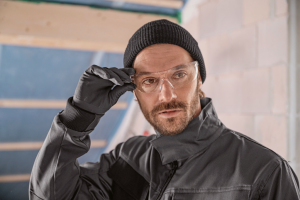Step into health
Quality safety footwear is essential to protect workers from external damage, buit can prevent and manage common foot conditions. Clair Weston provides an insight.

HEALTHY FEET are essential for a healthy workforce. Safety footwear should be designed not just to protect from external hazards, but also to support foot health and help prevent common conditions like plantar fasciitis, bunions, over-pronation, and musculoskeletal issues. With the latest updates to EN ISO 20345:2022 footwear standards, products that combine compliance, protection, comfort, and sustainability should be a priority.
The importance of foot health in the workplace
Our feet play a vital role in our everyday lives, especially for workers who spend prolonged hours standing, walking, or lifting. They act as natural shock absorbers and balance stabilisers. However, foot health is often only considered once pain or injury sets in.
Discomfort, even if mild at first, can lead to:
- Reduced concentration and productivity
- Time off due to injury
- Poor posture and compensatory strain on knees, hips, and lower back
- Long-term chronic pain
A case study from uvex illustrates this well: One manufacturing employee, working 12-hour shifts on a production line, experienced intense foot and back discomfort, just three to four hours into each shift. The persistent pain affected his performance and overall well-being, ultimately leading to extended sick leave. After undergoing a uvex footwear Fit Clinic assessment, he was provided with safety footwear featuring the appropriate cushioning to support his feet, back, and joints during long hours of repetitive motion on the production line. In addition, he was issued a pair of width-fitting insoles, allowing for subtle adjustments to the internal dimensions of the shoe further enhancing comfort. The result? He returned to full shifts, significantly more comfortable and regained his productivity.
Common workplace foot conditions and how the right footwear can help
According to the College of Podiatry, around 1 in 4 adults in the UK experience foot pain at any given time. Over 80% of people will experience a foot problem at some point in their lives. People in standing or walking-intensive roles have a significantly higher incidence of foot issues in general.
1. Plantar fasciitis
Plantar fasciitis is one of the most common and persistent causes of heel pain, often resulting from prolonged standing, repetitive impact, or inadequate arch support. This condition involves inflammation of the plantar fascia, which is a thick band of tissue connecting the heel bone to the toes. Inflammation in this area can cause sharp, stabbing pain for some, especially with the first steps in the morning while others experience a dull ache once the fascia becomes fatigued.
Safety footwear with advanced cushioning systems and reinforced heel stability can minimise the strain on the plantar fascia. Meanwhile, ergonomic footbeds and shock-absorbing midsoles can help distribute pressure more evenly across the foot helping to relieve symptoms. The right footwear can therefore help prevent the onset of plantar fasciitis and support recovery for those already experiencing symptoms.
2. Pronation & supination issues
Improper foot alignment, such as overpronation (excessive inward rolling of the foot) or supination (outward rolling), can significantly disrupt gait mechanics and contribute to chronic stress on joints, including the ankles, knees, hips, and lower back. These biomechanical imbalances are often exacerbated by unsupportive or poorly fitted footwear.
Safety footwear that provides support around the ankle and heel can help counteract these issues. Footwear should help guide movement without being too rigid and restrictive. Supportive footwear typically includes cushioning insoles, anatomical footbeds, and robust heel counters that promote a neutral foot position. This aids in proper alignment throughout the kinetic chain, helping to reduce fatigue, prevent injury, and improve comfort for users with pronation or supination tendencies.
3. Bunions
Bunions, or hallux valgus, are painful bony protrusions that form at the base of the big toe, often worsened by tight, narrow, or ill-fitting shoes. Continuous pressure on the metatarsophalangeal joint can lead to inflammation, discomfort, and progressive joint misalignment.
Safety footwear with wide toe boxes and styles that are available in different width options and materials, can provide the necessary space and flexibility to accommodate foot shape variations. This reduces direct pressure on the bunion area, alleviates pain, and helps prevent the condition from worsening.
Why footwear WEARability matters
Safety footwear isn't effective if it’s not worn consistently and correctly. WEARability; how comfortable, breathable, and suited to the task the footwear is, has a major impact on whether workers use it properly throughout the day.
Safety footwear designed with WEARability in mind should include:
- Lightweight construction to reduce fatigue on long shifts.
- Breathable linings and climate-optimised materials to minimise heat and sweat buildup, keeping feet dry and reducing the risk of skin conditions.
- Ergonomically designed soles and insoles to support natural movement and reduce pressure points.
- Smart fit systems ensure a secure yet comfortable fit, enhancing stability without discomfort.
High WEARability means footwear becomes part of a worker’s daily routine, rather than a burden. Workers are more likely to consistently wear their PPE correctly, reducing injury risk and enhancing safety culture on site.
Quality footwear shows you care about your workforce
When employees are provided with safe, supportive, and comfortable footwear:
- They feel cared for, which improves morale and job satisfaction.
- Physical discomfort and fatigue decrease, boosting productivity.
- Long-term health issues and absenteeism are minimised.
In industries with high physical demands and tight margins, staff turnover can be a significant cost. Poor footwear can lead to disillusionment, burnout, and early exits. On the other hand, when companies take a proactive approach to foot health, such as offering personalised fit consultations or upgrades to high-performance safety footwear, it demonstrates a commitment to employee wellbeing. It is not uncommon for staff retention to improve when workers know their health and comfort are prioritised.
Modern footwear for modern standards: EN ISO 20345:2022
Responsible employers who value employee comfort as well as safety should look for footwear that doesn’t just meet but exceeds the demands of the latest EN ISO 20345:2022 standard. This comprehensive update includes:
Water Resistance (WR & WPA)
- WPA: Allows minimal absorption, ideal for intermittent wet exposure.
- WR: Confirms total water resistance with no internal penetration, critical for wet environments like construction or outdoor logistics.
Perforation Resistance (P, PS, PL)
- Differentiated testing for metal and non-metal insoles, with PS offering the highest level of protection against sharp objects.
Ladder Grip (LG)
- Footwear with the LG marking has tested transverse heel grip, ensuring better safety when climbing or working on ladders.
Hydrocarbon Resistance (FO)
- Indicates footwear has passed additional testing against fuels and oils.
Scuff Cap (SC)
- Reinforced toe area withstands extreme abrasion, increasing product lifespan.
Electrostatic Protection
- Categorised as conductive, antistatic, or insulating.
- Antistatic footwear (S1 and above) reduces risk in electronic, laboratory, or explosive environments.
Why fit matters
Every foot is different so every worker should be fitted with footwear best suited to their needs. Through consultation and foot measurement, such as through uvex Fit Clinics, the most suitable models and insole configurations can be identified, which includes width adjustment options.
Benefits of fit clinics
- Reduces trial-and-error when selecting footwear
- Prevents foot conditions through proactive design
- Helps return injured workers to full duty with the right support
This bespoke approach is what helped the production line worker return from long-term sick leave and complete full shifts again, pain-free.
Fit can be further improved with the right insoles which can help enhance comfort, support, and foot health. Suitable insoles help distribute pressure evenly, reduce strain, and aid alignment. Insoles with moisture-wicking properties improve hygiene and lower infection risks, with regular cleaning or replacement further enhancing hygiene and comfort. The right insole can also play a role in reducing pain and sustaining productivity.
Sustainability at the sole
Protecting people should also means protecting the planet. At uvex, we integrate sustainability at every stage of our footwear development and production processes and we encourage footwear buyers to carefully review their suppliers sustainability credential. Factors to look out for include:
1. Eco-friendly materials
Look for safety footwear made from responsibly sourced, recyclable, or non-toxic materials. Sustainable options may also include solvent-free adhesives and biodegradable components.
2. Energy-efficient production
Consider brands that prioritise low-energy, low-waste manufacturing processes. Companies using circular production models typically have a smaller environmental footprint.
3. Long-lasting durability
Durable footwear reduces the need for frequent replacements, helping minimise waste. Features such as reinforced scuff caps and abrasion-resistant materials contribute to extended product life cycles.
4. Sustainable packaging
Choose products shipped in recyclable or minimal packaging. Reduced plastic usage and recycled and recyclable packaging practices further lower the environmental impact.
5. Performance without compromise
Sustainability should enhance, not hinder, performance. The ideal safety footwear offers both reliable protection and environmentally responsible design, benefiting both workers and employers.
Better footwear for better working lives
The value of proper safety footwear extends far beyond protection from falling objects or sharp nails. It’s about comfort, health, confidence, and care. Footwear influences everything from posture to performance, and ultimately, business outcomes. Your employees are your most valuable asset. Support them from the ground up.
Clair Weston is head of marketing at uvex. For more information, visit www.uvex-safety.co.uk
HSM publishes a weekly eNewsletter, delivering a carefully chosen selection of the latest stories straight to your inbox.
Subscribe here






